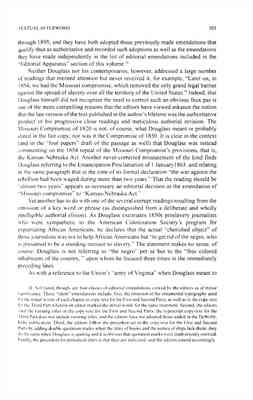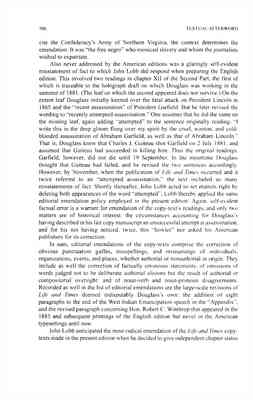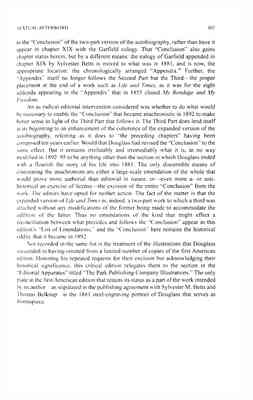Pages
21
TEXTUAL AFTERWORD
505
through 1895; and they have both adopted those previously made emendations that qualify thus as authoritative and recorded such adoptions as well as the emendations they have made independently in the list of editorial emendations included in the "Editorial Apparatus" section of this volume.31
Neither Douglass nor his contemporaries, however, addressed a large number of readings that merited attention but never received it, for example, "Later on, in 1854, we had the Missouri compromise, which removed the only grand legal barrier against the spread of slavery over all the territory of the United States." Indeed, that Douglass himself did not recognize the need to correct such an obvious faux pas is one of the more compelling reasons that the editors have viewed askance the notion that the last version of the text published in the author's lifetime was the authoritative product of his progressive close readings and meticulous authorial revision. The Missouri Compromise of 1820 is not, of course, what Douglass meant or probably stated in the fair copy; nor was it the Compromise of 1850. It is clear in the context (and in the "foul papers" draft of the passage as well) that Douglass was instead commenting on the 1854 repeal of the Missouri Compromise's provisions, that is, the Kansas-Nebraska Act. Another never-corrected misstatement of the kind finds Douglass referring to the Emancipation Proclamation of 1 January 1863, and relating in the same paragraph that at the time of its formal declaration "the war against the rebellion had been waged during more than two years." That the reading should be "almost two years" appears as necessary an editorial decision as the emendation of "Missouri compromise" to "Kansas-Nebraska Act."
Yet another has to do with one of the several corrupt readings resulting from the omission of a key word or phrase (as distinguished from a deliberate and wholly intelligible authorial elision). As Douglass excoriates 1850s proslavery journalists who were sympathetic to the American Colonization Society's program for expatriating African Americans, he declares that the actual "cherished object" of those journalists was not to help African Americans but "to get rid of the negro, who is presumed to be a standing menace to slavery." The statement makes no sense, of course: Douglass is not referring to "the negro" per se but to the "free colored inhabitants of the country," upon whom he focused three times in the immediately preceding lines.
As with a reference to the Union's "army of Virginia" when Douglass meant to
31. Not listed, though, are four classes of editorial emendations viewed by the editors as of minor significance. These "silent" emendations include, first, the omission of the ornamental typography used for the initial words of each chapter in copy-text for the First and Second Parts, as well as in the copy-text for the Third Part wherein an editor marked the initial words for the same treatment. Second, the editors omit the running titles in the copy-text for the First and Second Parts; the typescript copy-text for the Third Part does not include running titles, and the editors have not adopted those added in the DeWolfe, Fiske publication. Third, the editors follow the precedent set in the copy-text for the First and Second Parts by adding double quotation marks when the titles of books and the names of ships lack them; they do the same when Douglass is quoting and it is obvious that quotation marks were inadvertently omitted. Finally, the precedent for periodical titles is that they are italicized; and the editors emend accordingly.
22
506
TEXTUAL AHERWORD
cite the Confederacy's Army of Northern Virginia, the context determines the emendation. It was "the free negro" who menaced slavery and whom the journalists wished to expatriate.
Also never addressed by the American editions was a glaringly self-evident misstatement of fact to which John Lobb did respond when preparing the English edition. This involved two readings in chapter XII of the Second Part, the first of which is traceable to the holograph draft on which Douglass was working in the summer of 1881. (The leaf on which the second appeared does not survive.) On the extant leaf Douglass initially keened over the fatal attack on President Lincoln in 1865 and the "recent assassination" of President Garfield. But he later revised the wording to "recently attempted assassination." One assumes that he did the same on the missing leaf, again adding "attempted" to the sentence originally reading, "I write this in the deep gloom flung over my spirit by the cruel, wanton, and coldblooded assassination of Abraham Garfield, as well as that of Abraham Lincoln."
That is, Douglass knew that Charles J. Guiteau shot Garfield on 2 July 1881, and assumed that Guiteau had succeeded in killing him. Thus the original readings. Garfield, however, did not die until 19 September. In the meantime Douglass thought that Guiteau had failed, and he revised the two sentences accordingly. However, by November, when the publication of Life and Times occurred and it twice referred to an "attempted assassination," the text included as many misstatements of fact. Shortly thereafter, John Lobb acted to set matters right by deleting both appearances of the word "attempted"; Lobb thereby applied the same editorial emendation policy employed in the present edition. Again, self-evident factual error is a warrant for emendation of the copy-text's readings, and only two matters are of historical interest: the circumstances accounting for Douglass's having described in his fair copy manuscript an unsuccessful attempt at assassination, and for his not having noticed, twice, this "howler" nor asked his American publishers for its correction.
In sum, editorial emendations of the copy-texts comprise the correction of obvious punctuation gaffes, misspellings, and misnamings of individuals, organizations, events, and places, whether authorial or nonauthorial in orign. They include as well the correction of factually erroneous statements; of omissions of words judged not to be deliberate authorial elisions but the result of authorial or compositorial oversight; and of noun-verb and noun-pronoun disagreements. Recorded as well in the list of editorial emendations are the large-scale revisions of Life and Times deemed indisputably Douglass's own: the addition of eight paragraphs to the end of the West Indian Emancipation speech in the "Appendix"; and the revised paragraph concerning Hon. Robert C. Winthrop that appeared in the 1883 and subsequent printings of the English edition but never in the American typesettings until now.
John Lobb anticipated the most radical emendation of the Life and Times copytexts made in the present edition when he decided to give independent chapter status
23
TEXTUAL AFTERWORD
507
to the "Conclusion" of the two-part version of the autobiography, rather than have it appear in chapter XIX with the Garfield eulogy. That "Conclusion" also gains chapter status herein, but by a different means: the eulogy of Garfield appended in chapter XIX by Sylvester Betts is moved to what was in 1881, and is now, the appropriate location: the chronologically arranged "Appendix." Further, the "Appendix" itself no longer follows the Second Part but the Third—the proper placement at the end of a work such as Life and Times, as it was for the eight addenda appearing in the "Appendix" that in 1855 closed My Bondage and My Freedom.
An as radical editorial intervention considered was whether to do what would be necessary to enable the "Conclusion" that became anachronistic in 1892 to make better sense in light of the Third Part that follows it. The Third Part does lend itself at its beginning to an enhancement of the coherence of the expanded version of the autobiography, referring as it does to "the preceding chapters" having been composed ten years earlier. Would that Douglass had revised the "Conclusion" to the same effect. But it remains irrefutably and irremediably what it is, in no way modified in 1892–95 to be anything other than the section in which Douglass ended with a flourish the story of his life into 1881. The only discernible means of eliminating the anachronism are either a large-scale emendation of the whole that would prove more authorial than editorial in nature, or—even more a- or antihistorical an exercise of license—the excision of the entire "Conclusion" from the work. The editors have opted for neither action. The fact of the matter is that the expanded version of Life and Times is, indeed, a two-part work to which a third was attached without any modifications of the former being made to accommodate the addition of the latter. Thus no emendations of the kind that might effect a reconciliation between what precedes and follows the "Conclusion" appear in this edition's "List of Emendations," and the "Conclusion" here remains the historical oddity that it became in 1892.
Not recorded in the same list is the treatment of the illustrations that Douglass succeeded in having omitted from a limited number of copies of the first American edition. Honoring his repeated requests for their excision but acknowledging their historical significance, this critical edition relegates them to the section in the "Editorial Apparatus" titled "The Park Publishing Company Illustrations." The only plate in the first American edition that retains its status as a part of the work intended by its author—as stipulated in the publishing agreement with Sylvester M. Betts and Thomas Belknap—is the 1881 steel-engraving portrait of Douglass that serves as frontispiece.


